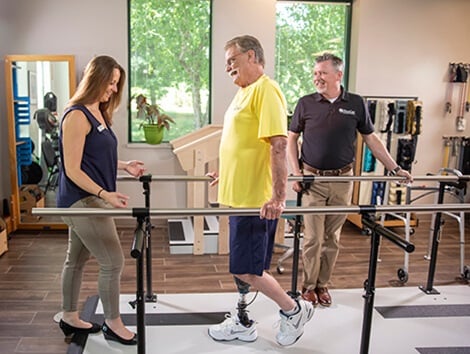Prosthetics & Orthotics
Providing expert prosthetics and orthotics care
Kessler Rehabilitation Center focuses on your needs and goals. Our team is passionate about building trust and providing care in a positive, healing environment.
Your care at Kessler Rehabilitation Center begins with a conversation to learn about you, your lifestyle and how we can achieve your goals. Our experienced, highly trained team then custom-designs a prosthetic and/or orthotic device to fit your needs.
Customized prosthetics to meet your needs
Kessler Rehabilitation Center employs state-of-the-art technology to create prosthetics tailored to your needs, ensuring that you're as comfortable, independent and active as possible.
We fit patients with a variety of prosthetics:

- Upper extremity prosthetics, including fingers, partial hands and above or below the elbow arms
- Lower extremity prosthetics, including above and below the knee legs and feet
- Sockets and suspensions that help with the overall comfort and fit of the prosthetic
Getting a prosthesis is a life-changing event, and we are here to support and educate you throughout this process. A thorough evaluation is an essential first step in choosing the most appropriate prosthesis to meet your needs and achieve your goals. We then obtain an impression of your residual limb, create your custom device and fit it to your precise needs to ensure the prosthesis allows you to meet your full potential. As your activity level, body or goals change, we are here to help with adjustments that keep you active.
We consider you a lifetime partner, and, as such, we make sure you are receiving the best possible care. That's why we will coordinate our services with your primary care physician, physical and/or occupational therapist, peer counselor and support group.
Comprehensive orthotics care
Our team of orthotists work with you to find the right orthotic for your issue. We also educate you on its proper care and use.
We use the latest orthotic technology to make sure you receive the best care and outcomes.
Upper extremity
You depend on your hands and arms for daily activities and self-care. We offer options to help treat many conditions, including carpal tunnel, tennis elbow, arthritis, nerve injuries and surgical repair. We work with you to find the most appropriate device for your needs. Our orthotics focus on many areas of your body including:
- Fingers
- Wrist/hand
- Elbow
- Shoulder
Lower extremity
We utilize stance control technology, WalkAid, carbon fiber and other low profile designs. Our lower extremity orthotics focus on the:
- Ankle/foot
- Knee
- Hip
Spinal
Our team has specialized training in spinal bracing, spinal injuries and scoliosis (curvature of the spine). We can create braces for you in as little as two days. Our team creates orthotics for many spine issues including:
- Lumbar sacral
- Scoliosis
- Cervical
In addition, we also fit cranial helmets for infants.
Prosthetics & orthotics
-
Upper extremity prosthetic limbs require innovative solutions. Whether you want to throw a baseball or simply do every day activities, we will partner with you to provide a customized upper extremity prosthesis that fits your needs and goals. Our upper extremity solutions provide the most advanced, functional and cosmetically pleasing devices available:
- Myoelectric-controlled prostheses are electrically powered rather than being controlled by your limb’s muscle strength. Myoelectrics are designed to mimic your motion. They use electrodes to pick up signals from the remaining muscles in your residual limb. These signals communicate various commands asking: the elbow to flex and extend, the wrist to bend and rotate, the hand to open or close. If muscle signals are not an option, additional inputs are available.
- Body-powered prostheses rely on the muscles of your body to power the prosthesis’ movements.
There are many options available for hands, wrists, elbows, arms and control mechanisms that offer comfort and an appealing design.
-
Whether you want to run a marathon or simply go for a walk, we can help. Our lower extremity program is built on experience and dedication. Our goal is to deliver designs that take you to the next level in function and comfort. We are committed to providing you with the device that will best meet your needs and help you reach personal goals.
We also partner with licensed physical and occupational therapists to design individualized treatment plans that include: strengthening and balance activities, prosthetic gait training and fall prevention
-
Socket fit is the most important part of your prosthesis and has the best impact on success in rehabilitation. A socket connects your residual limb to your prosthesis and should feel comfortable, stable and it should fit well. If the socket doesn’t fit properly, you may experience pain, sores, blisters, trips and falls and your prosthesis will feel heavy and awkward.
The socket remains in place on the limb. Suspension mechanisms are part of socket design and chosen prior to casting. Suspension can be achieved through:
- Mechanical lock, which is a pin or lanyard attached at the end of a roll-on liner which engages into a lock in the socket.
- Suction suspensions, which include seal-in liners and direct skin contact. Air may be released via a pump or valve to achieve even adhesion.
- Anatomical suspension, which is achieved when the contours of the socket capture and hold onto the limb.
Our highly trained practitioners will discuss all options with you to ensure you receive the best fitting and functioning device for your unique needs.
-
If you are concerned your child’s head is misshapen and repositioning is not improving head shape, it is important to talk to your pediatrician to identify any underlying causes. Potential conditions causing your child’s head shape include:
Plagiocephaly, flattening to one side of your baby’s head – often associated with torticollis, a shortening of neck muscles
Brachycephaly, flattening across the entire back of child’s head, causing it to appear wide and high
Scaphocephaly, long and narrow head shape, most common in premature birth and prolonged side-laying infants
These conditions have become more common since the “Back to Sleep” initiative was ushered in during the early 1990s. The initiative helped to prevent Sudden Infant Death Syndrome by encouraging parents to have their infants sleep on their backs. With this lack of “tummy time,” head asymmetries have risen.
Our certified cranial remolding specialists are experts in repositioning techniques and will fit your child with a Starband® custom-made helmet that will address your child's head shape. While every child is different, he/she will likely wear the helmet 23 hours a day for three to nine months. Duration is based on the age of your child and severity of the asymmetries.
-
Kessler Rehabilitation Center is your advocate and partner. We work to coordinate resources, navigate the health care system, and provide treatment options that meet your needs. The following links may prove helpful on your journey:
